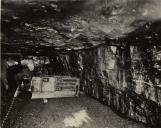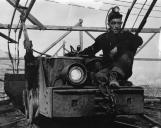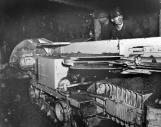1
As years progressed and industry grew, the technology used for mining advanced at a rapid rate. Compressed air was a thing of the past and electricity was running machinery underground. Electric locomotives replaced pit ponies in the main haulage, and could pull large trips with ease. In one area the Atlas was on the forefront of tecnology, blasting. In the early 30's, the Atlas was the first to switch from black powder and dynamite to compressed carbon dioxide, or cardox. All of these advances in technology increased the valley's yearly output dramatically.In the early days, underground machinery ran on compressed air. As mines became more mechanized electricity underground became more and more common. Using electricity underground was considered dangerous however, because of potential sparks and explosions. Earlier fears dissipated, and by 1925 almost thirty percent of the mines in Alberta were driven mainly by electricity.
3
Electricity underground made way for many machines that would increase production in the coming years. Coal cutters eliminated trench digging for miners, and coal loaders made coal loading faster. Even things as simple as lights underground made underground shops more efficient. However, miners at the coal face had only their cap lamps for light.6
Underground at the Elgin Mine. Two men operating a coal cutting machine, at the coal face.Between 1920 - 1940
Drumheller, Alberta
 Credits:
Credits:W.J. Oliver
Atlas Coal Mine Historical Society
7
Pony driver Bobby McNeil with pony and coal car20th Century
Unknown
 Credits:
Credits:Atlas Coal Mine Historical Society
8
Although pit ponies continued to haul coal in Alberta mines as late as the 1950's, the electric locomotive would take over the main haulage of the coal. These "Mancha Mules", along with mine trollies, allowed for an increase in production that ponies could not keep up with.9
Biz Griffin at Monarch #2 riding trolley locomotive1941
East Coulee, Alberta
 Credits:
Credits:Atlas Coal Mine Historical Society
10
l-r: George Bouchard and Jimmy Mitchell running locomotive underground at the Jewel Mine1927
Wayne, Alberta
 Credits:
Credits:Town of Drumheller
11
The methods for extracting coal from the coal face were changing too. In the early years, coal was shot down with black powder or dynamite. Atlas was the first mine to switch from black powder and dynamite to compressed carbon dioxide, or cardox. Cardox was a great way to dislodge the coal with less damage. This resulted in larger and more valuable pieces of coal.12
Miner underground at the Lehigh Mine, drilling with a hand held auger.20th Century
Lehigh, Alberta
 Credits:
Credits:Alf Brinkman
13
Underground at the Western Crown Mine. Fireboss inserting a cardox shell.1951
Unknown
 Credits:
Credits:Atlas Coal Mine Historical Society


